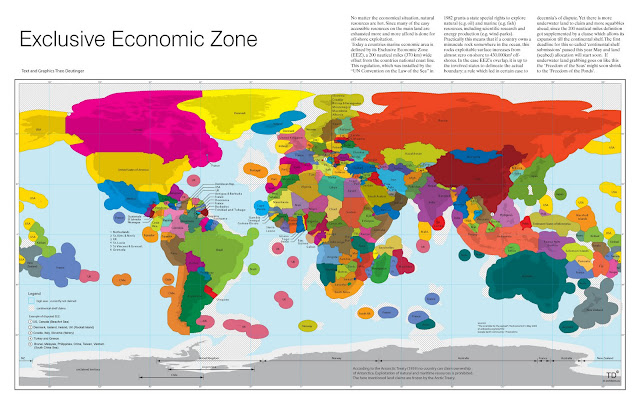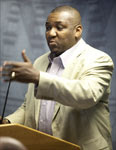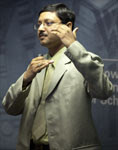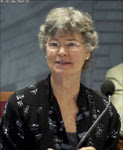Showing posts from category *Blog Columns.
-
Natural Resource Frontiers at Sea
›As burgeoning populations and growing economies strain natural resource stocks around the world, countries have begun looking to more remote and difficult-to-access resources, including deep-sea oil, gas, and minerals. The UN Convention on the Law of the Sea (UNCLOS) guarantees exclusive access to these resources within 200 nautical miles of a nation’s sovereign territory – called an exclusive economic zone (EEZ). TD Architects’ “Exclusive Economic Zone” illustrates this invisible global chessboard and highlights some examples of disputed areas, such as the South China Sea, the Mediterranean, the Falkland/Malvina Islands, and the Arctic.
-
Women Deliver 2010: First Impressions
›Delivering Solutions for Girls and Women
“We know how to intervene; there does not need to be a magical solution,” said Søren Pind, Denmark’s minister for development cooperation, at the June 7 opening ceremony of Women Deliver 2010.
In its second year, the conference has gathered delegates from 146 countries representing hundreds of non-governmental organizations (NGOs), governments, and civil society organizations under the theme “Delivering Solutions for Girls and Women.” Delegates are working to share projects, policies, successes, and innovations in the field of maternal health and to develop strategies to meet Millennium Development Goal 5.
“Recent trends show great progress and this is very encouraging,” said Gamal Serour, president of the International Federation of Gynecology and Obstetrics (FIGO), speaking of a recent study by the Institute of Health Metrics and Evaluation (IHME). The study found that annual maternal mortality has dropped 34 percent–from 526,000 to 342,900–between 1980 and 2008. Nevertheless, Serour maintained that “we are far away from our goal for 2015.”
Overcoming Tradition and Religious Barriers
Investing in women’s health is not only the right thing to do, it is also economically advantageous. When women are healthy, they provide tremendous benefits to their families, communities, and countries. Women contribute to a majority of the small businesses and agricultural activities of developing countries and their unpaid work at home accounts for almost 33 percent of the world’s GDP. Unfortunately, over 215 million of these women do not have access to family planning services, resulting in unwanted pregnancies, childbirth, and maternal deaths.
There are many barriers to family planning in developing countries, not the least of which are cultural and social traditions that can uphold negative gender-based norms. Tailoring campaigns to address these gender inequities was the subject of discussion at the “Cultural Agents of Change Delivering for Women” session, where panelists acknowledged that collaboration and partnership with a wide-range of actors–from members of the local legislature to civil society organizations and actors in the health sector–are necessary to facilitate change.
Graciela Enciso of the Centro de Investigaciones y Estudios Superiores en Antropología Social-Sureste in Mexico, added that advocacy campaigns to increase support for family planning should be “linked with research.” In many traditional societies, strict interpretations of religion are used to control and disempower women; donors and NGOs “need to think outside the religious box at every point,” said Mary E. Hunt, co-director at the Women’s Alliance for Theology, Ethics, and Ritual.
Male Contraception, Gender Roles, and Family Planning
“I think it is important not to hide behind our cultures and religion,” said Ngozi Okonjo-Iweala, managing director of the World Bank. “We need to work with men and work together to overcome gender inequality.” “Male participation” has been a key theme echoed throughout Women Deliver and is often highlighted as a strategy for reducing maternal mortality.
At the “Men Deliver: Men’s Role in Family Planning” breakout session, experts addressed how new and existing technologies in male contraception and shifting gender roles can help to scale up family planning interventions. “Reducing unwanted pregnancies can also be carried out through male contraception,” said John Townsend, vice president of the reproductive health program at the Population Council.
Condoms are traditionally the main method of contraception for men, but usage rates quickly fall over time and to wear a condom “becomes the women’s responsibility,” said Townsend. To address issues around condom usage, development of alternative family planning technologies, such as gels and implants, is underway. As these technologies are being developed, however, it is important for program managers and donors to consider existing gender norms and the willingness of men to utilize new methods.
In researching gender roles in family planning in Zambia, Holo Hochanda, the chief technical administrator of the Planned Parenthood Association of Zambia, determined that there are many entry points for male intervention and increased family planning. “Men are clients, policymakers, and service providers. Each of these roles provides an opportunity to discuss utilization of male contraception and gender inequities in family planning,” he said. “Men can be key mobilizers and agents for change.”
For more coverage on Women Deliver 2010 click here and to learn more about the Wilson Center’s Maternal Health Dialogue Series visit the Global Health Initiative’s website here. -
‘The Plundered Planet’: A Discussion With Paul Collier
› Who owns the planet’s natural wealth found underwater, below ground, and in the air? How do we reconcile our use of these assets with that of future generations? Such questions are the subject of Oxford Professor Paul Collier’s latest book, The Plundered Planet: Why We Must–and How We Can–Manage Nature for Global Prosperity, which he discussed at a recent Wilson Center event.
Who owns the planet’s natural wealth found underwater, below ground, and in the air? How do we reconcile our use of these assets with that of future generations? Such questions are the subject of Oxford Professor Paul Collier’s latest book, The Plundered Planet: Why We Must–and How We Can–Manage Nature for Global Prosperity, which he discussed at a recent Wilson Center event.
The author of The Bottom Billion and Breaking the Conflict Trap, Collier called Plundered Planet “the most important book I’ve written.” Resources are a “one-shot game,” he said; if we waste them, they’re gone. The next 10-20 years are “vital” to preserving natural assets as new technologies for removing them proliferate. We’re sucking fish up like “hoovers,” he said, and a combination of technology and economic growth are rapidly pushing mineral extraction into the few remaining frontiers.
Because time is short, Collier hopes his work will bring economists and environmentalists together. He said the two groups are largely at each other “cat and dog,” yet their objectives–environmental preservation and economic development–are not fundamentally opposed. In fact, to overcome polarization and produce key policy decisions, development and conservation must become partners.
Becoming Custodians, Not Curators
Collier said resource plunder can take one of two forms: “Where the few expropriate what belongs to the many”; and “where nature is expropriated by the present generation and burned up rather than benefiting future generations.” Both forms of plunder not only impede development, but are also unjust, he said.
Unlike other assets–such as books or records, which are typically owned by their authors or artists–natural assets have no human creators. A system whereby “natural assets are owned by the people who are lucky enough to live on top of them” creates “staggering inequality,” said Collier. Instead, resources must be shared equally among all citizens of a nation, including those not yet born.
Yet sharing nature’s wealth with generations to come does not mean leaving all fish in the sea, all trees on land, or all minerals underground. “We are not curators of natural artifacts,” Collier said. “We’re custodians of natural value.”
For the one billion people living in poverty, the development of natural resources can provide a path toward development, growth, and better lives, Collier argued, when properly and justly managed.
Filling the Gaps in Governance
Why have we largely plundered, rather than invested in, our resources thus far? What can be done to change the current principles of resource management? Collier’s short answer: governance.
For the poor countries in the “bottom billion,” Collier said the “broken decision chain” must be mended. The chain has six steps:- Discovering natural assets;
- Avoiding appropriation by a few at the expense of the many;
- Ensuring local inhabitants receive generous compensation for unavoidable environmental damage;
- Consuming in a way that benefits both the present and the future;
- Investing in the absorptive capacity of government; and
- Investing in domestic development.
Igniting a Movement
“There is no substitute…for building a critical mass of informed opinion,” Collier said. While technology enables plunder, it also creates a way for people to share knowledge at tremendous speeds and with wide audiences. The challenge, he said, “is to ignite the information transformation process.” A shift from plunder to sustainable management of transnational and developing country resources is a historic opportunity to benefit the world’s poor. “If these resources are harnessed for sustained development,” he said, “they can drag themselves decisively from poverty to prosperity.” The window of opportunity, however, is closing. -
Shrinking Desired Family Size and Declining Child Mortality
›Desired Number of Children: 2000-2008, a report prepared by Charles Westoff of Princeton University for USAID, reviews family size preferences in 60 countries. Taking its data from a series of Demographic and Health Surveys (DHS), the report found that “the number of children desired is declining in most of the developing world.” The noted exception is western and middle sub-Saharan Africa where, in some countries, 6.0 children remains the desired number. The report found that desire for smaller family sizes, rather than a reduction of unwanted births, was the primary factor behind the declining Total Fertility Rates (TFR) exhibited in most of the countries studied. It noted that men’s preference is close to, but larger than, that of women, and that preference sizes were declining even among women without formal education. The report concluded that preferred family size broadly depended upon “child mortality, Muslim affiliation, women’s education and empowerment, and exposure to the mass media.” In an article appearing in the latest The Lancet, researchers from University of Washington and University of Brisbane found that global child mortality has declined 35 percent since 1990, outpacing initial forecasts. Neonatal, Postneonatal, Childhood, and Under-5 Mortality for 187 Countries, 1970—2010: A Systematic Analysis of Progress Towards Millennium Development Goal 4 found that 31 developing countries are on track to achieve Millennium Development Goal 4 and that in certain regions, including sub-Saharan Africa, declines in mortality are actually accelerating. The report concludes that the positive trends in child mortality “deserve attention and might need enhanced policy attention and resources.”
In an article appearing in the latest The Lancet, researchers from University of Washington and University of Brisbane found that global child mortality has declined 35 percent since 1990, outpacing initial forecasts. Neonatal, Postneonatal, Childhood, and Under-5 Mortality for 187 Countries, 1970—2010: A Systematic Analysis of Progress Towards Millennium Development Goal 4 found that 31 developing countries are on track to achieve Millennium Development Goal 4 and that in certain regions, including sub-Saharan Africa, declines in mortality are actually accelerating. The report concludes that the positive trends in child mortality “deserve attention and might need enhanced policy attention and resources.” -
Improving Transportation and Referral for Maternal Health
›“Referral has been called an orphan cause,” said Patricia Bailey, public health specialist for Family Health International and Columbia University, because it is “everybody’s responsibility and therefore nobody’s responsibility.”
As part of the Maternal Health Dialogue Series the Woodrow Wilson International Center for Scholars’ Global Health Initiative convened a small technical meeting on May 19, 2010, with 25 experts from five countries to discuss their experiences and share lessons, challenges, and recommendations for improving transportation and referral for maternal health. Following the technical meeting, a public dialogue was held on May 20, 2010, to share the knowledge gaps and recommendations identified. The formal report from the technical meeting will be available in the near future.
Mobilizing District Communities in Rural Ghana
To improve maternal health care in Ghana, “we needed to shift [services] to the community level, where 70 percent of our population lives,” said Dr. John Koku Awoonor-Williams, the east regional director of Ghana Health Service. The “Community-based Health Planning and Services” (CHPS) program was created to galvanize local leadership and empower communities to engage in health outreach activities.
Through this approach, “community health officers and nurses are trained and delegated to distant village locations called CH[I]P zones, in which they are responsible for health education, treatment of minor illnesses, maternal and antenatal care, and referral to district hospitals for emergency care,” said Awoonor-Williams. Community health officers use two-way Motorola walkie-talkies to communicate with traditional birth attendants and referral centers. Pregnant women are given the phone numbers so they can call in the event of complications.
1-0-8 Emergency Number for Improving Maternal Health in India
Many parts of the developing world do not have a 911-style emergency response service. To address this gap, the GVK Emergency Management & Research Institute in India developed the toll-free 1-0-8 telephone number for all medical, police, and fire emergencies.
“We assure every citizen that wherever you are, [if] you call us we will be there,” said Subodh Satyawadi, chief operating officer of GVK. In order to reach the 433 million people covered by GVK, they have:
“Although we address all kinds of emergencies, we heavily focus on maternal health…31 percent of emergencies are pregnancy-related,” said Satyawadi, who said that GVK’s emergency response system has helped save more than 200,000 mothers. Institutional deliveries have increased in the state of Gujarat by 92 percent. “We have been able to reduce maternal mortality by 20-25 percent in different geographies,” he said.- 19,623 EMTs and 10,000 doctors and other healthcare professionals
- 2,710 ambulances
- 16,300 call-center employees
Pre-Hospital Barriers: Reducing Maternal Morbidity in Bolivia
Women in Bolivia receive free maternal care. In cities like La Paz, emergency obstetric care is often available within a short distance. However, “37 percent of our maternal deaths [occur] at our hospitals,” said Víctor Conde Altamirano, OB/GYN of CARE Bolivia.
To better understand this mortality rate, Altamirano evaluated whether pre-hospital barriers and routine antenatal care are associated with near-miss morbidity. He found that women who are older, have lower levels of education, lack antenatal care, are pregnant for the first time, or live in rural areas are at a greatest risk of illness or death
“We are trying to organize our communities and service facilities, and promote improved health management by the municipalities. If our authorities can be sensitive and invest in health; invest in fuel, drugs, and human resources; we can improve near-miss morbidity rates,” said Altamirano.
Strategies and Recommendations for Improving Transportation & Referral
The workshop participants agreed on six key topic areas for improving transportation and referral:1. Multi-sectoral collaboration
The group called for improved multi-sectoral engagement and continuous dialogue among key ministries: Health, Finance, Communication, Social Welfare, Security and Defense, Transportation, and Public Works.
2. Mobile phone technology
3. Public-private partnerships
4. Referral for newborns
5. Indicators for referral
6. Sharing evidence
Private-public partnerships, such as those demonstrated by GVK in India and the CH[I]P program in Ghana, create opportunities for collaboration. “Cell-phone technology can reduce delays in transport and treatment by identifying which facilities might be the most appropriate for referral,” said Bailey.
The final recommendation by the group calls for increased pooling and use of existing evidence to move the transportation and referral agenda forward. Updated synthesis papers on existing evidence are needed, said Bailey. “We have a lot of data that is perhaps less than perfect, but this should not be a barrier for further action,” she said. -
VIDEO: Family Planning in Conflict Areas
›“Displaced people are like every other human being, they want, they need the advantage of family planning. They are asking only for services to be available for them, affordable for them, and acceptable for them,” said Dr. Grace Kodindo in a recent interview with ECSP about the challenges of family planning in conflict regions. The OB/GYN from Chad calls for family planning services to be included in the provisions made for displaced and refugee communities.
Kodindo identified five key barriers to family planning for displaced people, including a lack of coherent policies for displaced people in host countries and a lack of awareness and attention by donors to family planning. Other barriers include the lack of access in remote areas, and a lack of knowledge and therefore demand.
However, in many cases family planning services are very much in demand. One refugee mother compared herself to a “hen being followed by many chicks,” said Kodindo, who “ask[s] the government and the donors to give and to make policy that can really facilitate the provision of services and to provide funding so that services can be available to all these people.”
Kodindo, who recently spoke at a Wilson Center panel on “Family Planning in Fragile States,” is also speaking in DC on Thursday, June 3 at a showing of the documentary about her work in the Democratic Republic of the Congo, Grace Under Fire. -
Top 10 Posts for May 2010
›Fragile states and food security top the Beat this month:
1. VIDEO—Harriet Birungi: Challenges Facing HIV-Positive Adolescents in Kenya
2. On the Beat: The Food Security Debate: From Malthus to Seinfeld
3. Guest Contributor Michael Kugelman, Wilson Center: Look Beyond Islamabad To Solve Pakistan’s “Other” Threats
4. As Somalia Sinks, Neighbors Face a Fight to Stay Afloat
5. Copper in Afghanistan: Chinese Investment in Aynak
6. Feed the Future: USAID’s Shah Focuses on Women, Innovation, Integration
7. Eye on Environmental Security: USAID Launches GeoExplorer: Connecting Natural Resource Management Activities, Practitioners, and Communities
8. Guest Contributor: Todd Walters, International Peace Park Expeditions: Imagine There’s No Countries: Conservation Beyond Borders in the Balkans
9. DOD Measures Up On Climate Change, Energy
10. Campus Beat: Finding a Home for Political Demography -
Voices of World Water Day: Water and Health
›“Inadequate access to water supply, sanitation, and hygiene cause the deaths of over 1.5 million children each year,” Secretary of State Hilary Clinton said at the National Geographic Society and Water Advocates’ “World Water Day 2010” event. Her address marked a warmly welcomed recognition by the U.S. government of the strong connections between water and health.
“Voices of World Water Day” is a video capturing highlights of the discussion on water and health. Created by PATH and Water Advocates, it seeks to keep the messages and momentum from World Water Day alive and to share them with others.
Importantly, Clinton was not alone in her recognition, and her sentiments were widely shared among the event participants representing both the public and private sectors. Congressmen, Clarissa Brocklehurst of UNICEF, and William Asiko of the Coca-Cola Africa Foundation – to name a few – all weighed in on the necessity of clean, available water for public health.












